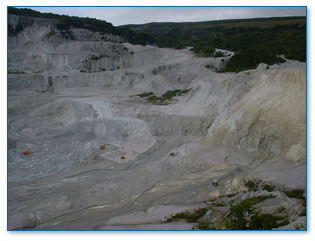case
study – quarrying
A quarrying company caused a
serious pollution incident when a pipe burst. Over time the pipe
had become worn out with the material being continually pumped through
it, and under pressure the weakest link had failed. The content
of the pipe was a thick liquid mixture of clay minerals and water
from the quarry. As a result the mixture entered the watercourse
at its source (refer to B03
River System).
 |
A quarry |
The clay mixture entering the
river meant that there was an increased amount of particles in the
water being carried by the river. Mineral particles can clog the
gills of fish such as trout and salmon and when the particles settle
on to the river bed they smother the invertebrates that live in
and on the river bed. Fortunately, the particles were so fine that
they were easily carried down the river and flushed through with
the next flood, but bigger particles can clog up all the gravel
that lies on the river bed. Moving down river the pollution was
also diluted as other tributaries joined the river and river inhabitants
(refer to minibeasts B09a)
were able to survive.
 |
Lavrean stream,
Cornwall after china clay spill |
The quarry operators responded
immediately to the accident by pumping the polluted water into an
old pit. Here it was allowed to stand for a few days. During this
time the particles in the water sank out of the water down to the
bottom.
Sensors are now put in all rivers
where there might be a risk of a similar problem happening. These
sensors monitor the particles that the river is carrying and an
alarm is triggered when a certain level of particles in the water
is reached. Then pollution is investigated.
 |
Quarry water channels |
A system of valves, channels and catch pits have also been installed
at the quarry to stop spillages from sections of pipe that are at
high risk from causing pollution of the river. These incidents result
in the company being prosecuted and having bad publicity for causing
pollution.
To find out more about
how rivers are monitored in this way look at the Environment Agency’s
website www.swenvo.org.uk/environment.
|

